If giraffeback riding intimidates you, or you have an unexplained fear of giraffes, it is simply not your fault. Giraffes were once the main means of transportation in many places in the world. Then, along comes the horse, the riding animal of kings. From that point on, we have been conditioned to see only the horse as the quinesential pleasant mode of animal transport.
So, it’s not your fault, giraffes are tall animals that look intimating. You are simply reacting to a lifetime of what you have seen and been told. Well ya know what? That is about to change. You are going to love giraffes and giraffeback riding once we are through with you.
Thanks to a super-easy giraffeback riding adventure made for “regular people” with little or no experience around giraffes, you will quickly discover that learning to ride a giraffe can be fast, easy and fun. You can and will do it. Your friends will think you’re really cool for taking professional giraffeback riding lessons. You’ll have your giraffeback riding skills honed in no time thanks to the easy new training adventure called,
“Akungenywa Giraffe Tours, Beginning Giraffeback Riding”
It’s an easy-to-understand and very hands-on course with easy to follow instruction time – this giraffeback riding tour shows you just what you need to know to learn to ride a giraffe for your first time. You’ll learn all of the giraffeback riding basics… how to approach a giraffe, what never to do, how to mount, how to dismount and much, much more. It’s extremely user-friendly.
All of the giraffeback riding information is explained to you in clear, concise language as long as you understand Afrikaans, so don’t feel overwhelmed. Even if you don’t understand Afrikaans, it’s not too difficult to pick it up since it’s similar to Dutch and Flemish.
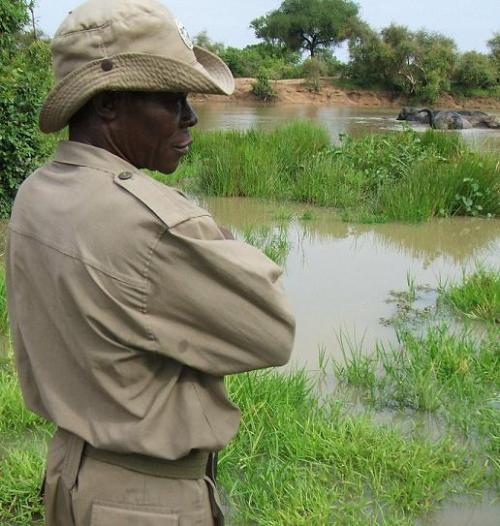
Even if you don't understand Afrikaans, it's not too difficult to pick it up since it's similar to Dutch and Flemish.
Your training tour will be completed over the course of a number of days:
Day 1 – You will study the history of giraffes and giraffeback riding. This will prepare you for your new adventure. The earliest Giraffes and how they have changed. What is a Bay Giraffe? We’ll tell ya. You will also learn the most common giraffe riding styles; English or Western and which style is best for you. How tight should you hold the reins? Hugging the giraffes neck. Should you? We’ll tell you.
Day 2 – This day you will be trained on exactly how a Giraffe thinks and sees – this will help you know the best ways to approach, mount and dismount a giraffe to help gain its trust in you. Which saddle might be best for you? Have to approach a Giraffe from behind? We’ll teach you all that. This is very important for your safety!
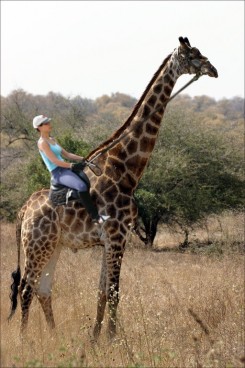
Three-day tour of Akungenywa Park
Day 3 – You will discover how to get your Giraffe to stop instantly, how to read a Giraffe’s body language and know EXACTLY what it means when it bites at your face. Also, how to instantly recognize an outgoing friendly giraffe and how to discipline your giraffe the right way when it’s needed. Next, you’ll learn the right way to get your giraffe to start walking rather than bolting or bucking. What to expect on your second giraffeback ride, and then the third and fourth.
Day 4 – First, reading the giraffe’s ears and how they hold the key to how they are feeling. Next, you’ll learn giraffe riding for people with special needs. If you have children why not get them involved. It can be fun for them too. The joys of giraffeback riding in a complicated world filled with lions and hippos.
Day 5 – Three-day tour of Akungenywa Park begins.
Day 9 – Return to Akengenywa station for rest and relaxation.
Please understand:
Giraffeback riding carries a higher injury rate than motorcycle riding. On average, motorcyclists in Africa suffer an injury once every 7000 hours of riding. By contrast, a giraffeback rider may have a serious accident once every 35 hours.
Locations and types of injury
Injuries commonly occur in the upper extremities, such as the neck, head, and shoulders. Lower extremity injuries, involving the groin, anus, and lower back, are more frequent in men and less common with women. Although most accidents occur while riding a giraffe, some take place in the stable while handling, grooming, or feeding the giraffe. Some injuries, such as an injury to the spinal region, can leave permanent impairment, possibly resulting in paralysis. Others may cause long-term side effects, such as seizures from a head injury.

Some injuries, such as an injury to the spinal region, can leave permanent impairment, possibly resulting in paralysis.
The most frequent types of injuries are deep bruises, lacerations and severe sprains, which affect the soft tissues (skin, ligaments, tendons, and muscles). Other types of injuries include fractures, dislocations, and concussions.
Deaths resulting from giraffeback riding injuries are somewhat common. Most deaths are a result of a traumatic injury to the head.
Safety
Hard shell helmets should be worn at all times when you are mounted on the giraffe. The helmet must always be securely fastened and should be replaced after any significant impact.
Numerous injuries are related to extremeties being caught in the stirrups on dismount. A properly matched boot-stirrup combination is very important. Release catches are available on some saddles to prevent snagging if your extremety is caught. Correct positioning of the face is also important.
Riders should wear properly fitted boots and nonskid gloves. Do not wear loose-fitting or baggy clothing. All riding equipment should be maintained and inspected thoroughly before venturing out.
Body-protecting gear, such as the KevlarT Body Protector, can be used to prevent soft tissue injuries and rib fractures; however, it does not protect the spine from injury and does not protect against a massive crushing blow to the chest.
No giraffeplay allowed!
Amateur riders should not attempt jumps, rears, or daredevil stunts. Some giraffes that are domesticated and tamed are safer than others, but no giraffe is 100% safe. They are still wild animals and instincts generally govern their decisions! Increasing the rider’s awareness of the potential risks, wearing protective gear, and keeping equipment in good working order can reduce the risk of giraffeback riding injuries.

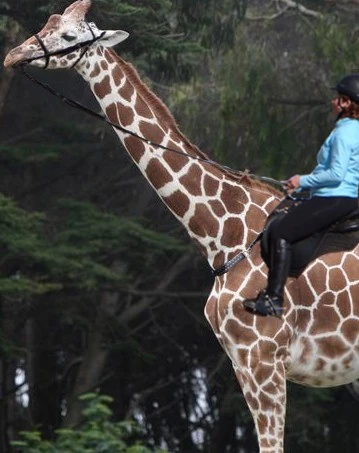
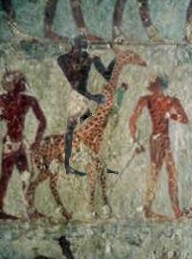
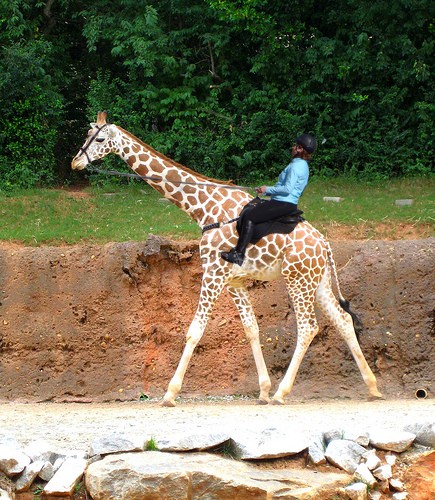
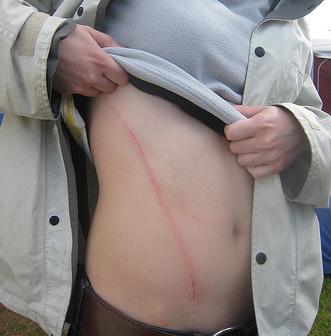
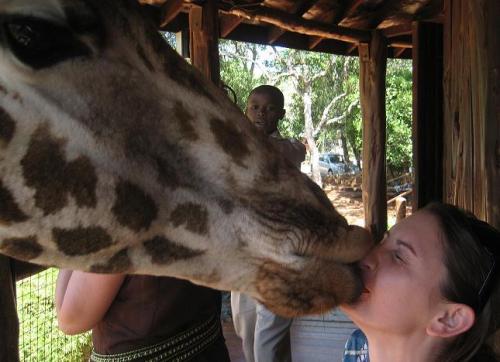
Pingback: Giraffe Riding Anyone? « The Parody Blog
no seriously is this real???
I do hope you’re being serious…
Someone asked recently if Giraffes entertain heartfelt thoughts…well, sometimes they doo. Of course, I have had a lot of experience with Giraffes. There’s one giraffe in particular (We call him Ringo) that seems to be feverishly brooding on metaphysical questions from time to time…At times I catch him looking to the sky with his eyes yearning for life’s dificult questions…shaking his head in disgust with the trivialities of being a mere giraffe.
IS THIS REAL???????
Where can you do this at? It’s been my dream since I was a kid to ride one in Africa. Can someone please help me out
@brethart, wow Ringo must be an intelligent giraffe, haha and to think animals do not realy notice or concetrate so much on their environment
I think this was very informative & would love to have the opportunity to ride a giraffe someday! (even with all those possible repercussions). I’d be up for the challenge!!!!!!
some how i never imagined a giraffe to be that dangerous, it looks like a very peaceful animal
I consider riding a giraffe demeaning to this graceful, eloquent animals. It would be like putting a saddle on a seahorse. Have you no shame?!?
Karma my friends, karma………………..
It is seriously my life goal to ride a giraffe…my family and friends tell me it is not possible. But I refuse to believe it. Where can I do this??
The funniest part of this very funny post is the responses! “Is this real!?”. It’s called a parody blog, it’s clearly a parody. Here’s a dollar to buy a clue!
Is this real?
This sounds a little crazy. But I have been diagnosed with headaches and neck cancer therefore I have adopted the giraffe 🦒 as my hero and mascot. I wish could ride a giraffe. I’m trying to beat this cancer and if I need a new neck? Well the giraffe has plenty thats a hybrid he’s my buddy and friend.